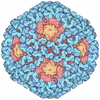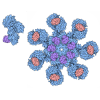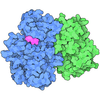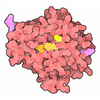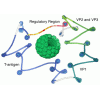[English] 日本語
 Yorodumi
Yorodumi- PDB-1olh: HIGH-RESOLUTION SOLUTION STRUCTURE OF THE OLIGOMERIZATION DOMAIN ... -
+ Open data
Open data
- Basic information
Basic information
| Entry | Database: PDB / ID: 1olh | ||||||
|---|---|---|---|---|---|---|---|
| Title | HIGH-RESOLUTION SOLUTION STRUCTURE OF THE OLIGOMERIZATION DOMAIN OF P53 BY MULTI-DIMENSIONAL NMR | ||||||
 Components Components | TUMOR SUPPRESSOR P53 (OLIGOMERIZATION DOMAIN) | ||||||
 Keywords Keywords | ANTI-ONCOGENE PROTEIN | ||||||
| Function / homology |  Function and homology information Function and homology informationnegative regulation of helicase activity / Loss of function of TP53 in cancer due to loss of tetramerization ability / Regulation of TP53 Expression / signal transduction by p53 class mediator / negative regulation of G1 to G0 transition / negative regulation of glucose catabolic process to lactate via pyruvate / Transcriptional activation of cell cycle inhibitor p21 / regulation of intrinsic apoptotic signaling pathway by p53 class mediator / negative regulation of pentose-phosphate shunt / ATP-dependent DNA/DNA annealing activity ...negative regulation of helicase activity / Loss of function of TP53 in cancer due to loss of tetramerization ability / Regulation of TP53 Expression / signal transduction by p53 class mediator / negative regulation of G1 to G0 transition / negative regulation of glucose catabolic process to lactate via pyruvate / Transcriptional activation of cell cycle inhibitor p21 / regulation of intrinsic apoptotic signaling pathway by p53 class mediator / negative regulation of pentose-phosphate shunt / ATP-dependent DNA/DNA annealing activity / Activation of NOXA and translocation to mitochondria / regulation of cell cycle G2/M phase transition / oligodendrocyte apoptotic process / negative regulation of miRNA processing / intrinsic apoptotic signaling pathway in response to hypoxia / regulation of fibroblast apoptotic process / positive regulation of thymocyte apoptotic process / oxidative stress-induced premature senescence / regulation of tissue remodeling / positive regulation of mitochondrial membrane permeability / mRNA transcription / bone marrow development / positive regulation of programmed necrotic cell death / circadian behavior / T cell proliferation involved in immune response / regulation of mitochondrial membrane permeability involved in apoptotic process / germ cell nucleus / RUNX3 regulates CDKN1A transcription / homolactic fermentation / TP53 Regulates Transcription of Death Receptors and Ligands / Activation of PUMA and translocation to mitochondria / TP53 regulates transcription of additional cell cycle genes whose exact role in the p53 pathway remain uncertain / histone deacetylase regulator activity / regulation of DNA damage response, signal transduction by p53 class mediator / negative regulation of glial cell proliferation / Regulation of TP53 Activity through Association with Co-factors / negative regulation of neuroblast proliferation / mitochondrial DNA repair / T cell lineage commitment / Formation of Senescence-Associated Heterochromatin Foci (SAHF) / ER overload response / thymocyte apoptotic process / B cell lineage commitment / TP53 Regulates Transcription of Caspase Activators and Caspases / entrainment of circadian clock by photoperiod / cardiac septum morphogenesis / negative regulation of mitophagy / negative regulation of DNA replication / Zygotic genome activation (ZGA) / Association of TriC/CCT with target proteins during biosynthesis / PI5P Regulates TP53 Acetylation / TP53 Regulates Transcription of Genes Involved in Cytochrome C Release / necroptotic process / positive regulation of release of cytochrome c from mitochondria / negative regulation of telomere maintenance via telomerase / SUMOylation of transcription factors / TP53 regulates transcription of several additional cell death genes whose specific roles in p53-dependent apoptosis remain uncertain / TFIID-class transcription factor complex binding / intrinsic apoptotic signaling pathway by p53 class mediator / rRNA transcription / negative regulation of reactive oxygen species metabolic process / Transcriptional Regulation by VENTX / cellular response to UV-C / replicative senescence / viral process / general transcription initiation factor binding / intrinsic apoptotic signaling pathway in response to endoplasmic reticulum stress / positive regulation of RNA polymerase II transcription preinitiation complex assembly / cellular response to actinomycin D / neuroblast proliferation / intrinsic apoptotic signaling pathway in response to DNA damage by p53 class mediator / positive regulation of execution phase of apoptosis / Pyroptosis / hematopoietic stem cell differentiation / embryonic organ development / response to X-ray / chromosome organization / type II interferon-mediated signaling pathway / somitogenesis / TP53 Regulates Transcription of Genes Involved in G1 Cell Cycle Arrest / hematopoietic progenitor cell differentiation / negative regulation of fibroblast proliferation / positive regulation of cardiac muscle cell apoptotic process / core promoter sequence-specific DNA binding / glial cell proliferation / negative regulation of stem cell proliferation / cellular response to glucose starvation / cis-regulatory region sequence-specific DNA binding / mitophagy / Regulation of TP53 Activity through Acetylation / positive regulation of intrinsic apoptotic signaling pathway / response to salt stress / 14-3-3 protein binding / mitotic G1 DNA damage checkpoint signaling / negative regulation of proteolysis / cardiac muscle cell apoptotic process / gastrulation / transcription repressor complex / MDM2/MDM4 family protein binding / transcription initiation-coupled chromatin remodeling Similarity search - Function | ||||||
| Biological species |  Homo sapiens (human) Homo sapiens (human) | ||||||
| Method | SOLUTION NMR | ||||||
 Authors Authors | Clore, G.M. / Omichinski, J.G. / Gronenborn, A.M. | ||||||
 Citation Citation |  Journal: Science / Year: 1994 Journal: Science / Year: 1994Title: High-resolution structure of the oligomerization domain of p53 by multidimensional NMR. Authors: Clore, G.M. / Omichinski, J.G. / Sakaguchi, K. / Zambrano, N. / Sakamoto, H. / Appella, E. / Gronenborn, A.M. | ||||||
| History |
|
- Structure visualization
Structure visualization
| Structure viewer | Molecule:  Molmil Molmil Jmol/JSmol Jmol/JSmol |
|---|
- Downloads & links
Downloads & links
- Download
Download
| PDBx/mmCIF format |  1olh.cif.gz 1olh.cif.gz | 2 MB | Display |  PDBx/mmCIF format PDBx/mmCIF format |
|---|---|---|---|---|
| PDB format |  pdb1olh.ent.gz pdb1olh.ent.gz | 1.7 MB | Display |  PDB format PDB format |
| PDBx/mmJSON format |  1olh.json.gz 1olh.json.gz | Tree view |  PDBx/mmJSON format PDBx/mmJSON format | |
| Others |  Other downloads Other downloads |
-Validation report
| Summary document |  1olh_validation.pdf.gz 1olh_validation.pdf.gz | 362.8 KB | Display |  wwPDB validaton report wwPDB validaton report |
|---|---|---|---|---|
| Full document |  1olh_full_validation.pdf.gz 1olh_full_validation.pdf.gz | 1.2 MB | Display | |
| Data in XML |  1olh_validation.xml.gz 1olh_validation.xml.gz | 106.6 KB | Display | |
| Data in CIF |  1olh_validation.cif.gz 1olh_validation.cif.gz | 154.6 KB | Display | |
| Arichive directory |  https://data.pdbj.org/pub/pdb/validation_reports/ol/1olh https://data.pdbj.org/pub/pdb/validation_reports/ol/1olh ftp://data.pdbj.org/pub/pdb/validation_reports/ol/1olh ftp://data.pdbj.org/pub/pdb/validation_reports/ol/1olh | HTTPS FTP |
-Related structure data
- Links
Links
- Assembly
Assembly
| Deposited unit | 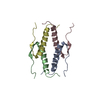
| |||||||||
|---|---|---|---|---|---|---|---|---|---|---|
| 1 |
| |||||||||
| NMR ensembles |
|
- Components
Components
| #1: Protein/peptide | Mass: 4948.632 Da / Num. of mol.: 4 Source method: isolated from a genetically manipulated source Source: (gene. exp.)  Homo sapiens (human) / References: UniProt: P04637 Homo sapiens (human) / References: UniProt: P04637 |
|---|
-Experimental details
-Experiment
| Experiment | Method: SOLUTION NMR |
|---|
- Processing
Processing
| Refinement | Software ordinal: 1 Details: THE 3D STRUCTURE OF THE OLIGOMERIZATION DOMAIN (RESIDUES 319 - 360) OF P53 BY MULTI-DIMENSIONAL HETERONUCLEAR-EDITED AND -FILTERED NMR IS BASED ON 3824 EXPERIMENTAL RESTRAINTS COMPRISING THE ...Details: THE 3D STRUCTURE OF THE OLIGOMERIZATION DOMAIN (RESIDUES 319 - 360) OF P53 BY MULTI-DIMENSIONAL HETERONUCLEAR-EDITED AND -FILTERED NMR IS BASED ON 3824 EXPERIMENTAL RESTRAINTS COMPRISING THE FOLLOWING INTRA- AND INTER-SUBUNIT RESTRAINTS: (A) INTRASUBUNIT: 840 SEQUENTIAL (|I-J|=1), 744 SHORT RANGE (1 < |I-J| >=5) AND 72 LONG RANGE (|I-J| >5) INTERRESIDUES AND INTRARESIDUE APPROXIMATE INTERPROTON DISTANCE RESTRAINTS, 136 DISTANCE RESTRAINTS FOR 68 HYDROGEN BONDS, 268 TORSION ANGLE (144 PHI, 104 CHI1 AND 20 CHI2) RESTRAINTS, AND 144 THREE-BOND HN-HA COUPLING CONSTANT RESTRAINTS. (B) INTERSUBUNIT: 96 A-B/C-D, 758 A-C/B-D, 10 A-D/B-C APPROXIMATE INTERPROTON DISTANCE RESTRAINTS, AND 24 DISTANCE RESTRAINTS FOR 12 HYDROGEN BONDS INVOLVING THE A-C/B-D SUBUNITS. IN ADDITION, THERE ARE A TOTAL OF 38 CALPHA AND 38 CB CHEMICAL SHIFT RESTRAINTS PER SUBUNIT THAT HAVE BEEN INCORPORATED INTO THE REFINEMENT [J. KUSZWESKI, J. QIN, A.M. GRONENBORN AND G.M. CLORE, J. MAGN RESON. SER IN PRESS (1994)] THE STRUCTURES ARE CALCULATED USING THE HYBRID METRIC MATRIX DISTANCE GEOMETRY-DYNAMICAL SIMULATED ANNEALING METHOD DESCRIBED BY: NILGES, M., CLORE, G.M. AND GRONENBORN, A.M. (1988) FEBS LETT. 29, 317-324. ALL STRUCTURAL STATISTICS ARE GIVEN IN THE JRNL REFERENCE. THE RESTRAINED MINIMIZED AVERAGE STRUCTURE (SA)R IS PRESENTED IN PROTEIN DATA BANK ENTRY 1OLG. THIS IS OBTAINED BY FIRST AVERAGING THE COORDINATES OF THE INDIVIDUAL 35 DYNAMICAL SIMULATED ANNEALING SA STRUCTURES BEST FITTED TO RESIDUES 324 - 356 OF ALL FOUR SUBUNITS, AND SUBJECTING THE RESULTING COORDINATES TO RESTRAINED MINIMIZATION. THE QUANTITY PRESENTED IN COLUMNS 61 - 66 IN THIS SET OF COORDINATES (THE B-FACTOR FIELD IN X-RAY STRUCTURES) GIVES THE AVERAGE RMS DIFFERENCE BETWEEN THE INDIVIDUAL SA STRUCTURES AND THE MEAN STRUCTURE. THE NUMBERS IN COLUMNS 61 - 66 OF THE INDIVIDUAL STRUCTURES HAVE NO MEANING. NOTE THAT RESIDUES 319 - 323 AT THE N-TERMINUS AND RESIDUES 357 - 360 AT THE C-TERMINUS ARE DISORDERED. |
|---|---|
| NMR ensemble | Conformers submitted total number: 35 |
 Movie
Movie Controller
Controller



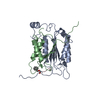
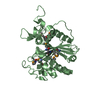
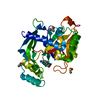

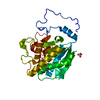
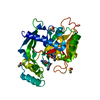
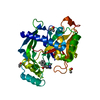
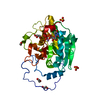
 PDBj
PDBj



